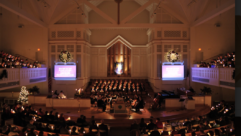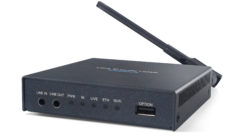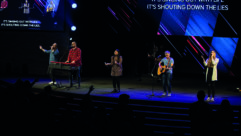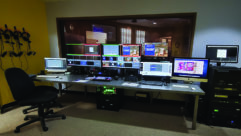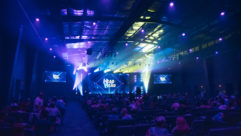
IMAG in Churches
Jan 1, 2006 12:00 PM,
By Anthony D. Coppedge
Image magnification do’s and don’ts.
Chart

IMAG enhances the intimacy of worship for the 7,200 attendees of Prestonwood Baptist Church in Plano, Texas.
For many houses of worship, IMAG (image magnification) is an attractive technological option for magnifying the action on the church platform — through the use of video-cameras — so that even those far away can see easily.
It’s true that if you sit more than 10 to 15 rows away from most church stages/platforms, you can’t see as much detail as someone sitting in the front row. For all but the smallest of churches, however, 10-15 rows away from the stage is a common seating situation, and people can still see enough detail that IMAG isn’t necessary.
But for larger churches, IMAG is an extremely useful way of making the audience feel more intimately involved in the proceedings. IMAG was developed for venues that were so large that a good portion of the attendees was missing important action. It makes sense to use IMAG in a 4,000-seat auditorium.
So why are so many small churches using small professional camcorders such as the Canon GL2 and XL1 or Sony PD150 to achieve IMAG in rooms that seat 800 or fewer? I think it’s because they want to emulate larger churches, and they think replicating the use of IMAG is a positive step in that direction.
Though I just generalized churches seating 800 or less as not being good candidates for an IMAG system, there certainly are exceptions. When a church client asks you to design an IMAG system, first determine if the venue would actually benefit from IMAG. There are two simple considerations that can help you walk the client through a needs analysis to discover if there is a need for IMAG. These are the space’s sightlines and the distance from the audience to the pastor.
Just because a room is small doesn’t automatically remove the possibility for using IMAG. For example, the design of many traditional Methodist churches includes the use of a large chancel and wraparound seating. It’s possible to consider adding screens across from either side of the chancel if the ceiling height and control of lighting allows for improved viewing of the pastor.
Another example is when a church is in a room with a very low ceiling or has multiple support columns blocking seats. Unlike in the previous example, it may not be possible to use front or rear projection screens. However, it might be possible to add a distributed video system using flat-panel monitors, such as LCD or plasma, behind each column or mounted on the ceiling to provide better views of the action on the platform.
Chances are you’ve been to a church that was in a long and narrow room. Often referred to as a “shoe-box” auditorium, these spaces can be relatively narrow but have seats that are 100ft. away or more. At these long distances, the intimacy that viewers experience close to the platform is not possible.

The author operates an Ikegami HK-387W, a television broadcast camera, at Prestonwood Church. Cameras are not the only significant expense of putting together an IMAG system.
PROS AND CONS OF IMAG
In a large church venue, recreating a sense of intimacy is a high priority for effective communication. IMAG allows church attendees to read the body language (especially the eyes) of the singers and teachers on the platform. So much of our communication extends beyond what we hear that it is important to provide as much intimacy as possible to the farthest row in the room.
The usage of IMAG, however, has a serious drawback: You have to show tight shots the vast majority of the time. This potentially limits how other information is presented on the screens.
A smaller church doesn’t have the same restraints, and can instead use the screen as a canvas to be painted with visual imagery. In larger churches, lower-third graphics (like a newscaster’s title) are often necessary in order to convey textual information and graphics. This introduces increased technical difficulty. And even with a CG/titling system in place, there’s limited space on the screen for song lyrics, scripture verses, and sermon points. In smaller churches, however, the entire screen real estate can be utilized, because the live video image doesn’t have to dominate the screen 90 percent of the time. Be sure to explain the freedom smaller churches have in using their creative palettes to enhance the service with visual content.
Another potential downside of adding IMAG is the considerable expense. The cameras, switchers, tripods, additional lighting, video reference monitors, and the rest of the gear associated with quality IMAG cost a lot of money. This tends to keep many of those smaller churches that don’t truly need IMAG from using it.
But because you’ll inevitably get a church client who has an “expert” volunteer insisting that the DV format has changed everything for churches, I’ve decided to go ahead and price out a bare-bones budget for a live DV-based video system. At nearly $28K, the budget IMAG video system really isn’t that much of a budget-saver (see the table on p. 38). I didn’t even include the pricing for displays, cabling, additional lighting, dimming, and power necessary to send high-quality video images to IMAG screens. My point is simple: In addition to being somewhat complicated, IMAG is expensive!
Here’s a litmus test for churches that do need IMAG: Does the image on the screen look like the image in the pulpit? The human eye sees a lot of detail, so it doesn’t make sense to display a live camera shot of a head-to-toe of the pastor that’s roughly as large as he looks to the eye. This means that those little prosumer cameras with 10-20X optical zoom will have to be within 20ft. to 30ft. of the pulpit in order to get a tight enough shot. Also, backlighting needs to be considered so that the background and the person don’t blend into one.
The bar is set rather high in order to meet the expectations of the vast majority of churchgoers, who regularly watch stunning video and film quality for hours every week. In order to make it look that good, the costs are very real and very high.

The worship band at Fellowship Church in Grapevine, Texas—another large house of worship that benefits greatly from IMAG.
OTHER USES OF IMAG
Lest I portray IMAG as reserved for the megachurch elite, allow me to offer a somewhat cautionary tale that shows how limited IMAG usage can benefit the smaller church venue. Bear in mind that this church ran into a number of difficulties in implementing its IMAG solution. Much of that could have been alleviated with some expert guidance and training, and that’s where you, the knowledgeable AV professional, come in. Always remember that a successful client relationship requires a degree of care and mainteneance that extends beyond simply delivering and installing the gear.
As for the specific application, it was sound in concept. For those churches rapidly outgrowing their current facilities, adding another room in the facility can be a solution for alleviating the space limitations. But there is a definite downside to making this move prematurely.
My friend Mick is the senior pastor of a church that currently hosts 250 people on Sundays. They meet at a small local movie theater that has about 100 seats. But because the theater is open late on Saturday and has noon showings on Sunday, the availability of the theater is problematic for adding services.
Mick opted to add an overflow room in an adjacent theater. He was able to have two bands play different music in the two rooms and billed the new service as the “unplugged version,” with an acoustical style that’s less rock-and-roll than the current service. This effectively doubled his space, but led to the problem of adding IMAG to send a live video feed of the preaching to the overflow theater.
At first, Mick enlisted the help of a local video pro who offered to loan them his “old broadcast gear” for free. Excited, Mick eagerly had him provide setup training to his team of technical volunteers. Even though the equipment was “broadcast-quality,” it needed a lot of maintenance and was difficult to set up and calibrate. It also didn’t work well with the minimal lighting associated with movie theaters. Frustrated, the technical team tried using a more modern Canon GL2 prosumer camera, which did handle the lower light levels better than the old broadcast gear but lacked the controls necessary to make smooth pans and zooms.
“Our volunteers were stressed through the roof,” Mick says. “Our volunteers are not equipped or trained to handle the huge learning curve of adding IMAG,” even with the help of the local video expert.
Now the church is looking for a larger venue so that it can keep steady influx of new and repeat visitors. “For us, the lesson I’m learning from this is that I tried to do too much too fast with too little. My thought was, ‘We’ve got to make this space work, so let’s try this,’ but I didn’t have the expertise,” says Mick. “I also didn’t have someone next to me who had the church’s best interest at heart. The ‘expert’ we used thought that the old gear was ‘good enough’ for a church. My second lesson was in leveraging the volunteers without adequate training. They didn’t know what they were doing, even though their hearts were right. The stress was too much. Volunteering stopped being fun. Yeah, we like to work hard and learn some things, but this is just too much.”
An exploding trend in houses of worship is the use of multiple venues within one campus that host different service styles, but with the same message (sermon). Similar to multi-venue is multi-site, in which other venues are set up off-campus and share the sermon video feed. In both of these situations, IMAG from the main auditorium is recorded and projected on side screens while a separate, lock-down shot of a center-mounted and unmanned camera is projected onto a third large center screen that reproduces this medium-wide shot of the stage.
For these applications, a minimum of three cameras (two for IMAG and one for lock-down) is necessary. More cameras will usually help with the production quality, so consider that in the budgeting process. Extra record and playback decks, switchers, and projectors will likely also be necessary, so make sure that your church client understands the major costs and personnel needs that are involved with this kind of technology decision.
With the vast potential for churches to hear about, read about, and actually see IMAG being used in other churches, it’s important that you address your client’s interest. Work with them to define their needs, provide viable options, and, most important, let them know when they should and should not consider investing in IMAG. You might pass up a few lucrative design contracts or installs, but the church will appreciate your honesty, expertise, and integrity. And in this market, those three commodities are the best way to expand your church clientele.
Anthony Coppedgeprovides consulting to churches for developing and growing a media ministry, building teams, casting vision, and choosing the right equipment. He lives in Bedford, Texas, with his wife and two daughters and can be reached at[email protected].


